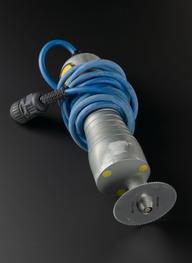





Model of simple cord and torque handle tourniquet as used by Morell in 1678, made by W.H. M.M., c. 1930
This is one of the first examples of a tourniquet. Morell’s simple cord and wooden handle was used on the battlefield in Besançon, France, in 1674 during the Franco-Dutch War. The tourniquet was used to stop heavy bleeding. The cord is placed around the injured leg or arm and the wooden handle turned to tighten the cord. This copy was made by the Wellcome Workshops so it could be displayed in the Wellcome Institute of the History of Medicine.
Details
- Category:
- Surgery
- Collection:
- Sir Henry Wellcome's Museum Collection
- Object Number:
- A600744
- Materials:
- cord, cotton and handle, wood
- Measurements:
-
overall: 20 mm x 13 mm x 97 mm, .02kg
- type:
- tourniquet




